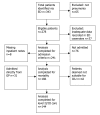Physiological-social score (PMEWS) vs. CURB-65 to triage pandemic influenza: a comparative validation study using community-acquired pneumonia as a proxy
- PMID: 17328822
- PMCID: PMC1819377
- DOI: 10.1186/1472-6963-7-33
Physiological-social score (PMEWS) vs. CURB-65 to triage pandemic influenza: a comparative validation study using community-acquired pneumonia as a proxy
Abstract
Background: An influenza pandemic may increase Emergency Department attendance 7-fold. In the absence of a validated "flu score" to assess severity and assist triage decisions from primary into secondary care, current UK draft management recommendations have suggested the use of CURB-65 and chest X-ray as a proxy. We developed the Pandemic Medical Early Warning Score (PMEWS) to track and triage flu patients, taking into account physiological and social factors and without requiring laboratory or radiology services.
Methods: Validation of the PMEWS score against an unselected group of patients presenting and admitted to an urban UK teaching hospital with community acquired pneumonia. Comparison of PMEWS performance against CURB-65 for three outcome measures: need for admission, admission to high dependency or intensive care, and inpatient mortality using area under ROC curve (AUROC) and the Hanley-McNeil method of comparison.
Results: PMEWS was a better predictor of need for admission (AUROC 0.944) and need of higher level of care (AUROC 0.83) compared with CURB-65 (AUROCs 0.881 and 0.640 respectively) but was not as good a predictor of subsequent inpatient mortality (AUROC 0.663).
Conclusion: Although further validation against other disease datasets as a proxy for pandemic flu is required, we show that PMEWS is rapidly applicable for triage of large numbers of flu patients to self-care, hospital admission or HDU/ICU care. It is scalable to reflect changing admission thresholds that will occur during a pandemic.
Figures
Similar articles
-
Evaluation of triage methods used to select patients with suspected pandemic influenza for hospital admission: cohort study.Health Technol Assess. 2010 Oct;14(46):173-236. doi: 10.3310/hta14460-03. Health Technol Assess. 2010. PMID: 20923612
-
Comparison of CATs, CURB-65 and PMEWS as triage tools in pandemic influenza admissions to UK hospitals: case control analysis using retrospective data.PLoS One. 2012;7(4):e34428. doi: 10.1371/journal.pone.0034428. Epub 2012 Apr 3. PLoS One. 2012. PMID: 22509303 Free PMC article.
-
Performance of the Pandemic Medical Early Warning Score (PMEWS), Simple Triage Scoring System (STSS) and Confusion, Uremia, Respiratory rate, Blood pressure and age ≥ 65 (CURB-65) score among patients with COVID-19 pneumonia in an emergency department triage setting: a retrospective study.Sao Paulo Med J. 2021 Mar-Apr;139(2):170-177. doi: 10.1590/1516-3180.2020.0649.R1.10122020. Sao Paulo Med J. 2021. PMID: 33681885 Free PMC article.
-
Clinical review: mass casualty triage--pandemic influenza and critical care.Crit Care. 2007;11(2):212. doi: 10.1186/cc5732. Crit Care. 2007. PMID: 17490495 Free PMC article. Review.
-
Emergency department triage of acute heart failure triggered by pneumonia; when an intensive care unit is needed?Int J Cardiol. 2016 Oct 1;220:479-82. doi: 10.1016/j.ijcard.2016.06.228. Epub 2016 Jun 27. Int J Cardiol. 2016. PMID: 27390973 Review.
Cited by
-
Derivation and validation of a clinical severity score for acutely ill adults with suspected COVID-19: The PRIEST observational cohort study.PLoS One. 2021 Jan 22;16(1):e0245840. doi: 10.1371/journal.pone.0245840. eCollection 2021. PLoS One. 2021. PMID: 33481930 Free PMC article.
-
Predicting severe disease in patients diagnosed with seasonal influenza in the emergency department.J Am Coll Emerg Physicians Open. 2023 Sep 20;4(5):e13045. doi: 10.1002/emp2.13045. eCollection 2023 Oct. J Am Coll Emerg Physicians Open. 2023. PMID: 37745865 Free PMC article.
-
Prognostic accuracy of eight triage scores in suspected COVID-19 in an Emergency Department low-income setting: An observational cohort study.Afr J Emerg Med. 2024 Mar;14(1):51-57. doi: 10.1016/j.afjem.2023.12.004. Epub 2024 Jan 26. Afr J Emerg Med. 2024. PMID: 38317781 Free PMC article.
-
Severity of illness assessment for managing community-acquired pneumonia.Intensive Care Med. 2007 Dec;33(12):2043-4. doi: 10.1007/s00134-007-0896-4. Epub 2007 Oct 16. Intensive Care Med. 2007. PMID: 17938882 No abstract available.
-
Mortality predictors are not triage scores.Thorax. 2007 Nov;62(11):1015; author reply 1015. Thorax. 2007. PMID: 17965083 Free PMC article. No abstract available.
References
-
- UK Health Departments . UK Influenza Pandemic Contingency Plan. London, Department of Health; 2005. http://www.dh.gov.uk/PublicationsAndStatistics/Publications/Publications...
-
- Koopmans M, Wilbrink B, Conyn M, Natrop G, Nat H, Vennema H, Meijer A, Steenbergen J, Fouchier R, Osterhaus A, Bosman A. Transmission of H7N7 avian influenza A virus to human beings during a large outbreak in commercial poultry farms in the Netherlands. Lancet. 2004;363:587–593. doi: 10.1016/S0140-6736(04)15589-X. - DOI - PubMed
-
- Ewig S, Ruiz M, Mensa J, Marcos MA, Martinez JA, Arancibia F, Niederman MS, Torres A. Severe Community-acquired Pneumonia Assessment of Severity Criteria. Am J Resp Crit Care Med. 1998;150:1102–1108. - PubMed
Publication types
MeSH terms
LinkOut - more resources
Full Text Sources
Medical






